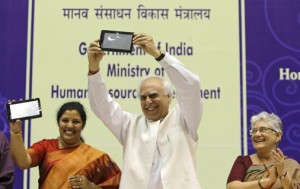 India’s Minister for Human Resource Development, Kapil Sibal launched Aakash, the $35 tablet, midst much fanfare last week. The launch was hailed as a grand moment for India’s innovative prowess and claims to have silenced the skeptics. Aakash is developed by DataWind, a wireless Web access products maker in Montreal in partnership with IIT Rajasthan. The tablet has a 7-inch display with 800-by-480 pixel resolution, 256MB of RAM, 2GB flash storage, a 366MHz processor from Connexant and runs on the Android 2.2 operating system. The tablet costs $50 but government of India is making it available for graduate students at the subsidized cost of $35. Making technology cheaply available is a great way to bridge the digital divide but Aakash is technologically unimpressive and socially insensitive.
India’s Minister for Human Resource Development, Kapil Sibal launched Aakash, the $35 tablet, midst much fanfare last week. The launch was hailed as a grand moment for India’s innovative prowess and claims to have silenced the skeptics. Aakash is developed by DataWind, a wireless Web access products maker in Montreal in partnership with IIT Rajasthan. The tablet has a 7-inch display with 800-by-480 pixel resolution, 256MB of RAM, 2GB flash storage, a 366MHz processor from Connexant and runs on the Android 2.2 operating system. The tablet costs $50 but government of India is making it available for graduate students at the subsidized cost of $35. Making technology cheaply available is a great way to bridge the digital divide but Aakash is technologically unimpressive and socially insensitive.
Based on initial reviews, the tablet is slow and the ‘resistive’ touchscreen implies that fast paced typing is challenging. Innovation does not imply lowering the quality of technology to lower the prices; social innovation involves making up-to-date technology readily available to larger segments of society. The three hour battery life implies over-dependence on erratic power supply, especially for people in the rural areas. Most importantly, the device will have very limited usability given the weak Wi-Fi network in India. Potentially, Aakash can connect a student to the world of information available on the Internet but access to Internet is still a huge problem in India. The argument that Aakash is simply the first step and the government will gradually work on making improvements for accessibility and usage is reflective of short-sighted decision making. It’s like saying that we’ll first manufacture world class cars and then plan on building roads and parking lots.
The challenge is not that Aakash is not comparable to the top end devices; technical specifications can be upgraded. The disturbing development is the attempt by Minister Sibal to project Aakash as the panacea for socially induced educational and digital gaps in India. Rather than accepting that Aakash as an experiment that would be technologically improved over the years, Mr. Sibal ridiculed any critical evaluation by stating that, tech watchers might mock the device but Indians should say this to naysayers: “It is not the device that is crude, it is your comments that are crude.” Given the room for improvement in Aakash and the fast paced nature of technological change, the Minister’s attitude appears unhelpful. Rather than an attempt to enhance the quality of education, Aakash is simple gesture at scoring political points and adding another bullet point on the Government’s list of achievements.
Aakash’s technological imperfections are defended by insisting that the market segment of this tablet are the ‘marginal and deprived’ in India. This sounds confusing. Large segment of this ‘marginal and deprived’ population does not have access to basic education and Aakash is to be distributed by the Government at the subsidized cost to graduate students. I doubt that many graduate students in metropolitan centers will want to identify with brand Aakash, while youth in the remote area will encounter internet connectivity issues. During the launch, Mr. Sibal so strongly asserted that Aakash was meant for the ‘deprived’ segment of society that instead of making the tablet a symbol of empowerment he has turned it into a symbol of the owner’s poverty. Given the ‘brand sensitivity’ among Indian youth, owing Aakash will be much like displaying a hi-tech BPL (Below Poverty Line) card. Rather than showcasing the technological prowess of the device, Mr. Sibal focused on its ‘cheapness’. The goal, according to Mr. Sibal is to reduce the prices to $10; qualitative improvements to the product don’t feature on his agenda. Aakash is not based on market trends but on political necessity. DataWind needs bulk orders to keep costs low and as a result Government of India is expected to buy 8 to 10 million units of the device by March 2012. What if the market demand for Aakash is lower than that? How will the government exhaust the inventory?
The rationale behind Aakash made complete sense – to make technology available for all segments of society. But by its very nature technological innovation is dynamic and competitive; mixing it with politics and projecting innovation as political achievement is dangerous. Taking criticism of Aakash as criticism of Government is likely to make the device obsolete. Technological innovation is successful and sustainable only when it meets the market demands and not simply because something new and cheap is made available.